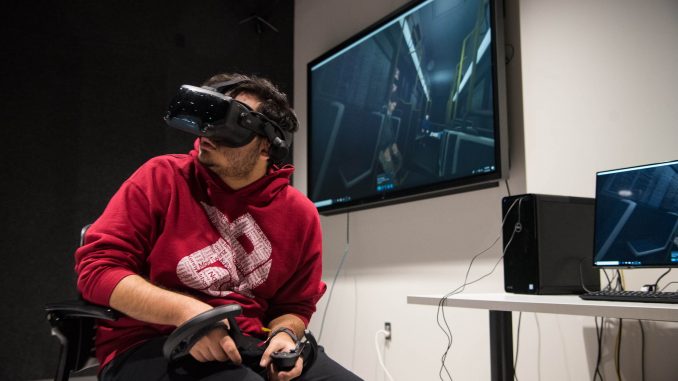
You’re in a barebones apartment. A pile of bills topped by an eviction notice sits on the desk before you. A radio to your left broadcasts a report about rising unemployment while your landlord knocks on your door, demanding rent that you don’t have.
This is the “Becoming Homeless” virtual reality simulation, which allows users to experience the process of being evicted, getting ticketed for sleeping in a car and riding a public bus through the night to stay warm.
All Temple University students are now able to access empathy training virtual reality simulations in the Loretta C. Duckworth Scholar’s Studio, located in Charles Library. The simulations depict a first-person view of experiencing homelessness and caregiving simulations both as a nurse and patient.
These types of simulations were first introduced to students several years ago when the Health Sciences Library began working with the VR simulation company Embodied Labs to try and incorporate virtual reality simulations into the nursing curriculum, said Jordan Hample, an academic information technology support technician at the studio.
“A lot of the same concepts used in nursing education are used in social work education, ” said Olivia Given Castello, library liaison to the School of Social Work, who worked with Hample for students to access the VR. “In both areas, schools are experimenting with this idea that experiences that build empathy will help students learn how to work as practitioners.”
By using virtual reality headsets and simulations, or computer-generated 3D visual imaging, students can gain insight into the daily struggles of future clients and patients through what Hample refers to as empathy training.
“Empathy training is essentially trying to put you into the body and or mindset of another person to try and experience what they are experiencing and try and understand how they might be dealing with any given time or circumstance,” Hample said.
Kazmuir Long, a student worker at the studio, helps students use the VR equipment.
“It’s an immersive experience that is fun for anyone,” said Long, a senior computer science major. “Even if you’ve never tried VR before, it’s really easy to get into.”
Since the technology allows students to focus on how the subject views their world rather than their reactions to scenarios, no knowledge about how to approach a homeless client or care for a person with an illness is required to partake in empathy training, Hample said.
“[The simulation] takes you through various stages of the illness,” he said. “Sometimes it’s visual impairment, so you’ll have part of the screen blocked off or blurry, or you’ll have a hearing impairment where you can’t quite make out what people are saying to you.”
The program has dozens of simulations of different diseases and conditions, like dementia, hearing impairment and blindness, so nursing students can view the challenges of caring for people with a variety of ailments, Given Castello said.
“When you see things from the perspective of the person with the illness, it helps you relate to what they’re going through, so when you’re trying to deal with someone who has that illness, then you might know how you need to handle that situation differently,” Hample said.
In one of the scenarios, students undergo the all-too-realistic situation of having to break bad news to family members of a patient, he added.
“It can be a hard conversation, so you get to sit through it and see what kind of reactions they might have and what you’re going to be dealing with,” Hample said.
Hample said that the VR training was beneficial for students to prepare for situations they are going to encounter in the real world.
“It’s very immersive,” he added. “You get to feel what they’re feeling and see what they’re seeing.”



Be the first to comment